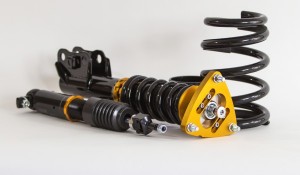“Should I install coilovers on my car?”
I feel like this question has been asked ever since Henry Ford put the Model T into production. Ok, maybe not that long ago, but it’s arguably one of the most commonly asked questions by enthusiasts looking to upgrade their vehicles suspension. So, what’s the correct answer?
Unfortunately I don’t think there is a “right” or “wrong” answer to this question. What we can do is ask questions like, “how do I use this car; street, show, drift, track/HPDE?”. “Why do I need to replace my current suspension?”. “What am I trying to improve by replacing the current suspension?”. “What are my expectations with installing an aftermarket suspension?”. “Do I want an adjustable suspension or something that doesn’t require tuning?”. “What conditions are the roads in that I normally drive on?”.
Some, or maybe all, of these questions should be asked when looking at replacing your vehicles suspension.
At ISC Suspension we offer a pretty wide variety of different suspension parts for multiple chassis’s; from Acura, BMW, Chevy, Ford, Honda, Hyundai, Lexus, Mazda, Mitsubishi, Nissan, Scion, Subaru, Toyota, VW and more. The part that we’re most commonly known for are our ISC N1 coilovers. Coilovers are known in general to do at least one thing; change the ride height of your vehicle. That’s very true of our coilovers too, but that’s not the only thing that they do. All ISC coilovers also have adjustable damping; 32-way adjustable. What does that mean? Dampers, or otherwise known as shock absorbers, are a key part of your vehicles suspension. When combined with the proper spring, they help dampen the compression (down stroke) and rebound (up stroke) of your vehicle. Without getting too far into damping, your dampers (or shocks) should be matched to not only the car, but also the springs as well as what type of driving you’ll be doing. Example; someone that is going to drive their vehicle back and forth to work everyday probably doesn’t need a super stiff spring/damper set up that is suited for extremely smooth surfaces (like a race track). Vice versa, the person that is going to bring their car to the race track MAY not want a super soft spring/damper set up as it might provide too much body roll making the car unsteady or unpredictable.
So, what are the advantages and disadvantages of installing an aftermarket coilover? Like one of the forefathers of our country (Benjamin Franklin) used to do, let’s write out the pro’s and con’s:
Pro’s – Adjustable ride height – adjustable damping – fully customizable – cost can be less than OE replacement parts (depends on chassis/manufacturer) – ability to balance chassis to perfect 50/50 weight distribution (corner balance, etc)
Con’s – Cost – increased NVH (noise, vibration, harshness)
These are the most common pro’s and con’s when people talk about coilovers. At ISC Suspension, we even believe that the con of “increased NVH” is really fully dependent on proper installation as well as application. Example; a customer that installs a solid top mount/camber plate on a race car usually expects a little more NVH when compared to the factory/OE suspension. In regards to common installation errors, feel free to check out our page here.
We also mentioned a “pro” being the ability to balance the vehicles chassis. Having a 50/50 weight distribution is something that every design engineer dreams of when creating the next great sports car. This is likely the biggest advantage a customer has when installing a set of coilovers on their car. It’s also one of the most under-utilized attributes when installing coilovers. Let’s face it, most customers install coilover suspensions on their vehicles, so they can dial in the exact ride height that they’ve always dreamt about. While that’s definitely one of pro’s of installing an aftermarket coilover suspension, you also run the risk of upsetting the balance of the vehicle. That exact balance that companies like BMW, Porsche, Honda, Mazda, Toyota, etc pay engineers millions of dollars to create. So, while you’ve given your vehicle a “fresh look” by soaking up that wheel gap, you’ve potentially also upset the balance of car. Depending on how much weight you’ve moved to each corner of the car, will determine how much the balance of the car will be off which in turn determines how the overall handling of the vehicle is affected. When people talk negatively about coilovers causing a “poor ride”, this uneven or change in weight distribution can often be the cause of that.
So, to sum up our question, “are coilovers right for me?”. Ask yourself some of the above questions or call our team at ISC Suspension; 603.715.9078. We’ll be happy to chat about what it is that you’re looking for!



Related Links
Why is it Important to Properly Align Your Suspension?
Monotube Vs Twin-Tube – What is the Difference? What is Better?
What is an Air Cup and How Do they Work?
BMW X-Drive Coilovers & Suspension
ISC Suspension Valving Options: Which One is Right for You?
SWIFT Springs; Optional Upgrade for many ISC Coilovers
Product Feature: ISC 240SX Rear TOE ARM
How to Setup a Drift Car – Proper Drift Settings
Triple S Coilover Springs – Does it Make a Difference?
What is the Best Coilover Ride Height for My Car?
ISC V3.1 Rear Adjustable Control Arms
Upgrades to Consider when Installing Coilovers
Should I install coilovers on my car?
What is the purpose of adjustable end links and how do they relate to my coilovers?
Difference between ISC N1 and Basic, which to choose?
